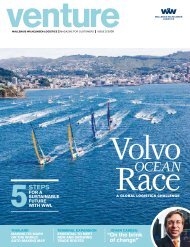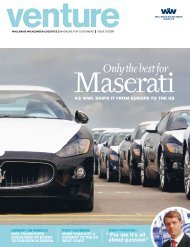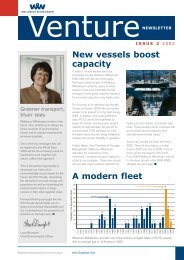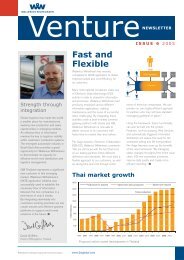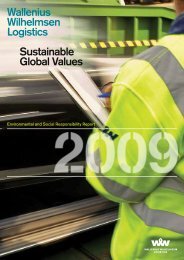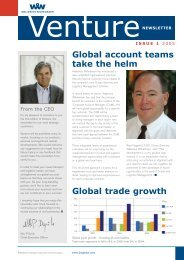DC GD69# 6I H:6# - Wallenius Wilhelmsen Logistics
DC GD69# 6I H:6# - Wallenius Wilhelmsen Logistics
DC GD69# 6I H:6# - Wallenius Wilhelmsen Logistics
You also want an ePaper? Increase the reach of your titles
YUMPU automatically turns print PDFs into web optimized ePapers that Google loves.
Ford honoured WWL<br />
with three logistics awards (see box). Its<br />
commitment to quality keeps WWL a<br />
trusted vendor.<br />
“Ninety-three percent of Ford vehicles<br />
are recommended by Consumer Reports,”<br />
says Ford International BU Vehicle <strong>Logistics</strong><br />
Department Manager Denny Carpenter.<br />
“That level of quality must carry<br />
over to our exported vehicles. That is the<br />
bottom line.”<br />
Working with Ford is Corporate Account<br />
Manager Kim Davis. She has wowed Ford<br />
<br />
<br />
<br />
<br />
with her ability to create efficient and seamless<br />
solutions to complex challenges.<br />
“The American manufacturers face<br />
many challenges,” says Davis, who also<br />
manages the General Motors account.<br />
“The question for us is, ‘How do we help<br />
them, with those challenges, to be successful?’<br />
The only way to do that is to<br />
understand your customer.”<br />
Winning the logistics awards is great<br />
for employee morale and strengthens the<br />
relationship between the two companies.<br />
But it does more than that.<br />
“It also shows the industry that we can<br />
live up to the high standards that Ford<br />
Motor Company has for us,” says WWL<br />
Executive Vice President John Felitto.<br />
“And that means that we can live up to<br />
demands of a world-class manufacturer.”<br />
<br />
<br />
<br />
<br />
<br />
<br />
<br />
<br />
<br />
<br />
<br />
<br />
<br />
<br />
<br />
<br />
<br />
<br />
<br />
<br />
<br />
<br />
<br />
<br />
<br />
<br />
<br />
<br />
<br />
<br />
<br />
<br />
<br />
<br />
<br />
<br />
<br />
<br />
<br />
<br />
<br />
<br />
<br />
<br />
<br />
<br />
<br />
<br />
<br />
<br />
<br />
<br />
<br />
<br />
<br />
<br />
<br />
<br />
<br />
<br />
<br />
<br />
<br />
<br />
<br />
<br />
<br />
<br />
<br />
<br />
<br />
Tata Motors has<br />
hit the headlines with the unveiling<br />
of Nano, a low-cost car that is set to<br />
bring private motoring to the masses<br />
in south Asia. When it goes on sale<br />
later this year, Nano will cost 100,000<br />
rupees or one lakh (that’s about<br />
€1,700 or $2,500).<br />
Okay, the Nano only has one windscreen<br />
wiper, no power steering, no radio<br />
and certainly no air conditioning.<br />
But it seats five people, meets current<br />
European emission standards and has<br />
a top speed of 105 km/hour. Nobody<br />
could dispute it offers value for money.<br />
A clear definition of what is a lowcost<br />
car is hard to find and largely<br />
depends on the local market.<br />
“The true definition of a low-cost<br />
car is elusive,” says industry analyst,<br />
Glenn Mercer. “The consensus seems<br />
to be €5,000 ($7,300) in the showroom,”<br />
he adds.<br />
“The automakers recognise they<br />
need low-cost cars to service emerging<br />
markets where customers simply<br />
cannot afford a typical €20,000<br />
($29,000) purchase price. Plus they<br />
help counter the threat of low-cost<br />
exports back into the established markets<br />
of Europe and North America.”<br />
Kearney forecast that<br />
global demand for cars priced below<br />
€3,500 ($5,000) will grow to 17 million<br />
units a year from 2020 with most of<br />
the sales coming from the Indian and<br />
south-east Asia sub-continent.<br />
Not surprisingly, most of the<br />
world’s major automakers are<br />
exploring the low-cost concept; the<br />
challenge is how to make a profit.<br />
Costs can be reduced by reusing old<br />
designs, sharing components or simplifying<br />
manufacturing.<br />
In Asia, Tata is likely to face competition<br />
from rival Indian manufacturer<br />
Maruti; Renault in partnership<br />
with scooter manufacturer Bajaj and<br />
GM-Daewoo, whose Matiz model already<br />
sells in some markets for under<br />
€3,000 ($4,400).<br />
Meanwhile more traditional carmakers,<br />
such as Toyota, Volkswagen<br />
and Renault (already selling the Dacia<br />
Logan at €6,000) see a global market<br />
in the €5,000 to €8,000 range, especially<br />
in central Europe.<br />
The carmakers will have to move<br />
fast. In China, where a fashion-conscious,<br />
urban middle-class is developing,<br />
customers are already moving<br />
upmarket and sales of more basic cars<br />
have started to fall.<br />
That leaves the interesting question:<br />
how long will the market for<br />
low-cost cars last??



